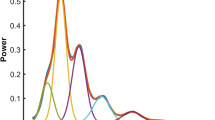Abstract
It has been suggested that functional dyspepsia might arise from the effect of stress on upper gut motility in susceptible individuals. The aim of this study was to evaluate postcibal antral motility in the presence and absence of sustained experimental stress by means of a transcutaneous electrical nerve stimulator. Two groups of patients could be recognized from these studies: first, those with postcibal antral hypomotility that was not changed during stress; and second, patients with normal postcibal motility which was normally suppressed by stress. Experimental stress significantly increased skin conductance and plasma β-endorphin levels. However, in these two groups, there were no differences in clinical presentation and personality traits or in autonomic and humoral variables either before or during stress. Stepwise discriminant analysis of the autonomic or humoral responses to stress was unable to predict the different postcibal antral motor responses among the subsets of patients with functional dyspepsia. These data suggest that there are two subtypes of antral motility in functional dyspepsia: (1) disordered gastric function under basal conditions resulting in antral hypomotility, and (2) normal basal antral motility and autonomic and gastric motor responses to stress. In the latter subgroup, the cause of symptoms is unclear, but it appears not to be a motility disorder.
Similar content being viewed by others
References
Rees WDW, Miller LJ, Malagelada J-R: Dyspepsia, antral motor dysfunction and gastric statis of solids. Gastroenterology 78:360–365, 1980
Lennard-Jones JE: Functional gastrointestinal disorders. N Engl J Med 308:431–435, 1983
Whorwell PJ, Clouter C, Smith CL: Oesophageal motility in the irritable bowel syndrome. Br Med J 282:1101–1102, 1981
Almy T: The irritable bowel syndrome: back to square one. Dig Dis Sci 25:401–403, 1980
Cannon WB: The influence of emotional states on the functions of the alimentary canal. Am J Med Sci 137:480–487, 1909
Wolf S, Wolff HG: Human Gastric Function. New York, Oxford University Press, 1947
Thompson DG, Richelson E, Malagelada J-R: Perturbation of gastric emptying and duodenal motility through the central nervous system. Gastroenterology 83:1200–1206, 1982
Thompson DG, Richelson E, Malagelada J-R: Perturbation of upper gastrointestinal function by cold stress. Gut 24:277–283, 1983
Stanghellini V, Malagelada J-R, Zinsmeister A, Go VLW, Kao PC: Stress-induced gastrointestinal motor disturbances in man: Possible humoral mechanisms. Gastroenterology 85:83–91, 1983
Camilleri M, Malagelada J-R, Kao PC, Zinsmeister AR: Influence of somatovisceral reflexes and selective dermatomal stimulation on postcibal antral pressure activity in man. Am J Physiol 247:G703-G708, 1984
Cottrell CR, Sninsky CA, Martin JL, Mathias JR: Are alterations in gastroduodenal motility responsible for previously unexplained nausea, vomiting and abdominal pain. Dig Dis Sci 27:650, 1982 (abstract)
Reboa G, Armulfo G, DiSomma C, Frascio M, Arzillo G, Bertiriboli E, Lucchetti G: Prokinetic effects of cisapride on normal and reduced antroduodenal motility and reflexes. Curr Ther Res 36:18–23, 1984
Malagelada J-R, Stanghellini V: Manometric evaluation of functional upper gut symptoms. Gastroenterology 88:1223–1231, 1985
Camilleri M, Malagelada J-R, Brown ML, Becker G, Zinsmeister AR: Relation between antral motility and gastric emptying of solids and liquids in humans. Am J Physiol 249:6580–6585, 1985
Camilleri M, Brown ML, Malagelada J-R. Altered gut transit in gastroparesis and pseudoobstruction syndromes: Correlation with regional motor dysfunction. Gastroenterology 88:1340, 1985 (abstract)
Latimer P, Sarna S, Campbell D, Latimer M, Waterfall W, Daniel EE: Colonic motor and myoelectric activity: A comparative study of normal subjects, psychoneurotic patients and patients with irritable bowel syndrome. Gastroenterology 80:893–901, 1981
Young SJ, Alpers DH, Norland CC, Woodruff RA: Psychiatric illness and the irritable bowel syndrome. Practical implications for the primary physician. Gastroenterology 70:162–166, 1976
Esler MD, Goulston KT: Levels of anxiety in colonic disorders. N Engl J Med 288:16–20, 1973
Clouse RE, Lustman PJ: Psychiatric illness and contraction abnormalities of the esophagus. N Engl J Med 309:1337–1342, 1983
Pearson JS, Swenson WM, Rome HP, Mataya P, Brannick TL: Further experience with the automated Minnesota Multiphasic Personality Inventory. Mayo Clin Proc 39:823–829, 1964
Schumacher GA, Goodell H, Hardy JD, Wolff HG: Uniformity of the pain threshold in man. Science 92:110–112, 1940
Kao PC, Heser D: Development of human β-endorphin radioimmunoassay with synthetic peptide. Clin Chem 26:961, 1980 (abstract)
Moyer TP, Jiang N-S: Optimized isocratic conditions for analysis of catecholamines by high performance reversedphase paired-ion chromatographic with amperometric detection. J Chromatogr 153:365–372, 1978
Moyer TP, Jiang N-S, Tyce GM, Sheps SG: Analysis of urinary catecholamines by liquid chromatography with amperometric detection: Methodology and clinical interpretation of results. Clin Chem 25:256–263, 1979
Winer BJ: Statistical Practices in Experimental Design. New York, McGraw-Hill, 1971, p 196
Wenger MA, Clemens TL, Coleman DR, Cullen TD, Engel BT: Autonomic response specificity. Psychosom Med 23:185–193, 1961
Wenger MA, Clemens TL, Cullen TD: Autonomic functions in patients with gastrointestinal and dermatological disorders. Psychosom Med 24:267–273, 1962
SAS Users Guide. Statistics, 1982 ed. Cary, North Carolina, SAS Institute Inc, 1982, pp 405–414
Swanson DW, Swenson WM, Huizenga KA, Melson SJ: Persistent nausea without organic cause. Mayo Clin Proc 51:257–262, 1976
Stanghellini V, Malagelada J-R, Zinsmeister A, Go VLW, Kao PC: Effect of opiate and adrenergic blockers on the gut motor response to centrally-acting stimuli. Gastroenterology 87:1104–1113, 1984
Lovallo W: The cold pressor test and autonomic function: A review and integration. Psychophysiology 12:268–282, 1975
Abram SE: Increased sympathetic tone associated with transcutaneous electrical stimulation. Anesthesiology 45:575–577, 1976
Barman SM, McCafferty TV, Wurster RD: Cardiovascular and electrophysiological responses to sympathetic pathway stimulation. Am J Physiol 230:1095–1100, 1976
Bajada S, Touraine A: Transcutaneous sympathetic stimulation: Effects on autonomic nervous system. Clin Exp Neurol 17:139–145, 1980
Smith OA, DeVito JL: Central neural integration for the control of autonomic responses associated with emotion. Annu Rev Neurosci 7:43–65, 1984
Ross CA, Ruggiero DA, Reis DJ: Afferent projections to cardiovascular portions of the nucleus of the tractus solitarus in the rat. Brain Res 223:402–408, 1981
Reis DJ, Cuénod M: Central neural regulation of carotid baroreceptor reflexes in the cat. Am J Physiol 209:1267–1279, 1965
Marlett JA, Code CF: Effects of celiac and superior mesenteric ganglionectomy on interdigestive myoelectric complex in dogs. Am J Physiol 237:E432-E436, 1979
Camilleri M, Malagelada J-R, Stanghellini V, Fealey RD, Sheps SG: Gastrointestinal motility disturbances in patients with orthostatic hypotension. Gastroenterology 88:1852–1859, 1985
Stunkard A, Koch C: The interpretation of gastric motility. I. Apparent bias in the reports of hunger by obese persons. Arch Gen Psychiatry 11:74–82, 1964
Whitehead WE, Drescher VM: Perception of gastric contractions and self-control of gastric motility. Psychophysiology 17:552–558, 1980
Whitehead WE, Schuster MM: Psychological management of the irritable bowel syndrome. Pract Gastroenterol 3:32–43, 1979
Whitehead WE, Engel BT, Schuster MM: Irritable bowel syndrome: Physiological and psychological differences between diarrhea-predominant and constipation-predominant patients. Dig Dis Sci 25:404–413, 1980
Author information
Authors and Affiliations
Additional information
This work was supported in part by grant AM 26428 from the National Institutes of Health.
Rights and permissions
About this article
Cite this article
Camilleri, M., Malagelada, J.R., Kao, P.C. et al. Gastric and autonomic responses to stress in functional dyspepsia. Digest Dis Sci 31, 1169–1177 (1986). https://doi.org/10.1007/BF01296514
Received:
Revised:
Accepted:
Issue Date:
DOI: https://doi.org/10.1007/BF01296514




